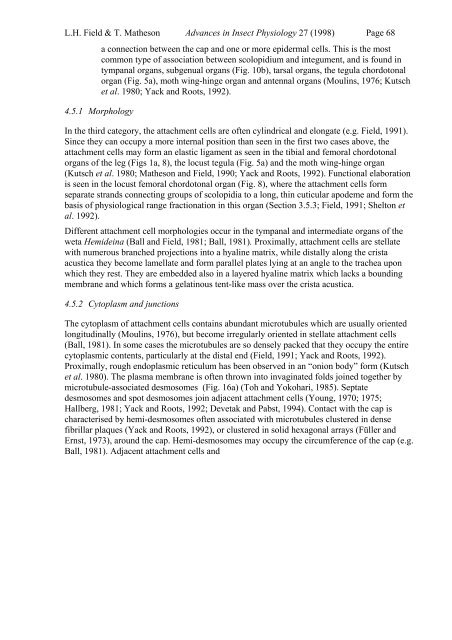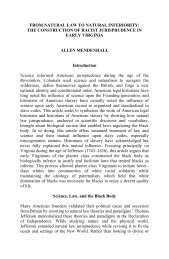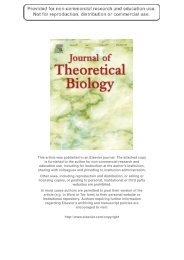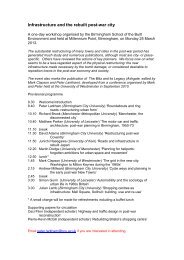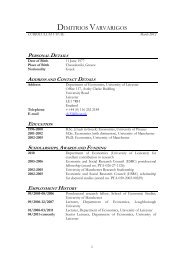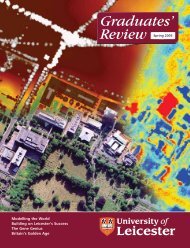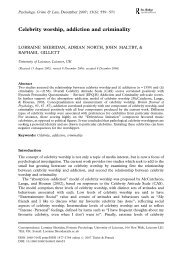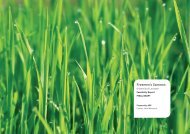Chordotonal Organs of Insects
Chordotonal Organs of Insects
Chordotonal Organs of Insects
You also want an ePaper? Increase the reach of your titles
YUMPU automatically turns print PDFs into web optimized ePapers that Google loves.
L.H. Field & T. Matheson Advances in Insect Physiology 27 (1998) Page 684.5.1 Morphologya connection between the cap and one or more epidermal cells. This is the mostcommon type <strong>of</strong> association between scolopidium and integument, and is found intympanal organs, subgenual organs (Fig. 10b), tarsal organs, the tegula chordotonalorgan (Fig. 5a), moth wing-hinge organ and antennal organs (Moulins, 1976; Kutschet al. 1980; Yack and Roots, 1992).In the third category, the attachment cells are <strong>of</strong>ten cylindrical and elongate (e.g. Field, 1991).Since they can occupy a more internal position than seen in the first two cases above, theattachment cells may form an elastic ligament as seen in the tibial and femoral chordotonalorgans <strong>of</strong> the leg (Figs 1a, 8), the locust tegula (Fig. 5a) and the moth wing-hinge organ(Kutsch et al. 1980; Matheson and Field, 1990; Yack and Roots, 1992). Functional elaborationis seen in the locust femoral chordotonal organ (Fig. 8), where the attachment cells formseparate strands connecting groups <strong>of</strong> scolopidia to a long, thin cuticular apodeme and form thebasis <strong>of</strong> physiological range fractionation in this organ (Section 3.5.3; Field, 1991; Shelton etal. 1992).Different attachment cell morphologies occur in the tympanal and intermediate organs <strong>of</strong> theweta Hemideina (Ball and Field, 1981; Ball, 1981). Proximally, attachment cells are stellatewith numerous branched projections into a hyaline matrix, while distally along the cristaacustica they become lamellate and form parallel plates lying at an angle to the trachea uponwhich they rest. They are embedded also in a layered hyaline matrix which lacks a boundingmembrane and which forms a gelatinous tent-like mass over the crista acustica.4.5.2 Cytoplasm and junctionsThe cytoplasm <strong>of</strong> attachment cells contains abundant microtubules which are usually orientedlongitudinally (Moulins, 1976), but become irregularly oriented in stellate attachment cells(Ball, 1981). In some cases the microtubules are so densely packed that they occupy the entirecytoplasmic contents, particularly at the distal end (Field, 1991; Yack and Roots, 1992).Proximally, rough endoplasmic reticulum has been observed in an “onion body” form (Kutschet al. 1980). The plasma membrane is <strong>of</strong>ten thrown into invaginated folds joined together bymicrotubule-associated desmosomes (Fig. 16a) (Toh and Yokohari, 1985). Septatedesmosomes and spot desmosomes join adjacent attachment cells (Young, 1970; 1975;Hallberg, 1981; Yack and Roots, 1992; Devetak and Pabst, 1994). Contact with the cap ischaracterised by hemi-desmosomes <strong>of</strong>ten associated with microtubules clustered in densefibrillar plaques (Yack and Roots, 1992), or clustered in solid hexagonal arrays (Füller andErnst, 1973), around the cap. Hemi-desmosomes may occupy the circumference <strong>of</strong> the cap (e.g.Ball, 1981). Adjacent attachment cells and


